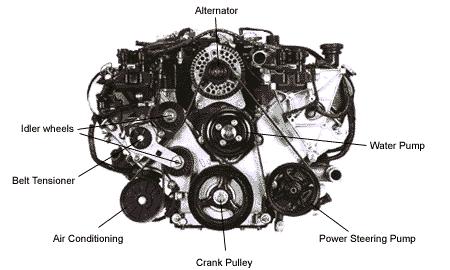This post is a continuation of Part 1 on What is Camshaft Position Sensor and Phase-shifting Pulley. Lately, we have gone through:
– What is a camshaft position sensor?
– How does a camshaft position sensor work?
– Maintenance of the camshaft position sensor
– Prices for camshaft position sensors
– Phase-shifting pulley: the different types of variable distribution
We will now cover:
– One more type of variable distribution, and we will further look at the following:
– Camshaft pulley timing system
– Advantages and disadvantages of the shading pulley
– Price of the maintenance of the phase shifter pulley
One more type of variable distribution
Exhaust: the burnt gases are pushed back to the piston’s exhaust; for this purpose, an exhaust valve, when opening, allows them to be evacuated.
Good to know: The opening and closing kinematics of the intake and exhaust valves are synchronized with the piston’s position.
In concrete terms, a camshaft is driven by the engine crankshaft via a synchronous system, consisting of the crankshaft sprocket and the fixed camshaft pulley (usually equipped with a toothed belt or chain with a sprocket).
Note: Piston speed, throttle inertia, different requirements (acceleration, deceleration, various engine loads related to the accelerator pedal’s position and the driver’s will) result in valve openings and closures that are unsuitable for different engine speeds.
The camshaft pulley timing system
It consists of a sprocket synchronized to the crankshaft by the belt or chain. It is connected to its hub (integral with the camshaft) by a variable connection allowing an angular shift of the hub to its position. This system makes it possible to shift the valves’ opening and closing according to the engine parameters.
The phase shift is actuated by oil pressure using a solenoid valve controlled by the engine control unit. A winding ramp mechanically ensures the variation in rotation.
Advantages and drawbacks of the phase-shifting pulley

It can only be performed by experienced technicians, as this function is critical to the engine.
The gains brought by the phasing pulley and its system are as follows:
- engine performance: operating flexibility – torque and power;
- control of pollution, promotes better combustion and fewer pollutants, particularly unburned hydrocarbons, carbon monoxide, and particles.
However, phasing pulley has a few disadvantages:
It is a complex system composed of hydraulics, mechanical and electrical connections, increasing the need for maintenance and the risk of malfunction;
It is expensive to maintain, especially concerning the price of spare parts and labor;
Although it allows the valves to be out of phase, it cannot meet the needs generated by the drastic anti-pollution standards:
The decoupling of the operation of each cylinder of the engine, first of all:
On low engine loads, it can cut one cylinder’s operation out of 4, for example.
The variation of the fresh gases’ volume: if the phasing pulley shifts the new gases’ arrival, it cannot modify their volume.
For example, this is the Honda VTEC system principle, which varies the valve opening height and the intake volume.
Price of the maintenance of the phase shifter pulley
Two serious possibilities are available to you:
Manufacturer maintenance
The maintenance is done through the brand network on which the vehicle depends: technical control is ensured: manufacturer’s documentation, knowledge of technical modifications and developments, equipment, etc. However, the manufacturer network’s liabilities include the high cost of parts and labor (between $50 and $100 per hour).
Order of idea of the average cost of a phasing pulley: $250.
Independent networks
These are multi-brand workshops or specialized workshops of independent networks: their labor is globally less expensive (from $60 to $80 per hour), the phase-shifting pulley’s cost (up to 40% less), and technical qualification remains equivalent to the manufacturer networks.
Note: However, a lack of technical equipment and knowledge of the latest developments or modifications can be felt in the multi-brand workshops, unlike the original manufacturers.
Next time the mechanic talks about the camshaft position sensor and phase-shifting pulley, you’ll know what he is talking about. If you wish to find a professional mechanic, we can get you in touch with one or more specialists in your area. Please, remember to leave your comments below.


